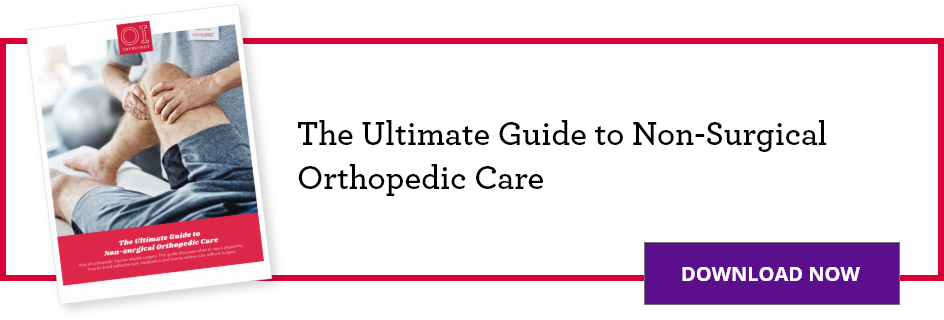THIS POST IS PART OF THE ULTIMATE GUIDE TO NON-SURGICAL ORTHOPEDIC CARE
Isthmic spondylolisthesis is a spinal condition that occurs when one of your vertebrae slips forward on to the one below it. This happens because of a defect or from a small fracture that has formed in the bone connecting the facet joints in your back. This causes your spine to be unstable.
Anatomy
The spine is made up of 24 bones, called vertebrae, which are stacked on top of one another. These bones connect to protect the spinal cord. The seven small vertebrae that begin at the base of the skull and form the neck comprise the cervical spine.
Your spinal cord and nerves travel through the spinal canal carrying messages between your brain and muscles. The intervertebral discs between your vertebrae are flexible, flat and round discs and are about a half-inch thick. They act as shock absorbers when you walk or run and allow motion between the vertebrae.
What causes isthmic spondylolisthesis?
Isthmic spondylolisthesis usually begins with a genetic condition and develops into one of your vertebrae slipping forward. The genetic defect is from bone formation failure. It usually affects the fourth and fifth vertebrae in the lumbar (lower) spine.
Since the bone wasn’t formed correctly in the first place, overuse and physical stress on your lumbar spine, or your lower back, causes the vertebrae to slip more often.
If you have this genetic condition, anything from lifting, bending over or twisting could cause small fractures to appear and a disc to slip. Young athletes like weightlifters, football players, gymnasts and anyone whose spine is under considerable stress is vulnerable to this condition.
About 4% of the population has isthmic spondylolisthesis.

What does isthmic spondylolisthesis pain feel like?
People who have isthmic spondylolisthesis may not have any symptoms. A lot of people don’t know they have the condition until they see a physician for a separate problem caused by your lack of bone formation. When symptoms occur, the pain will be felt in your lower back and sometimes down your legs.
- Muscle spasms
- Low back pain
- Sciatica
- Tight hamstring muscles
- Walking with a limp
- Leg pain or weakness
Can isthmic spondylolisthesis be corrected?
To determine whether you have isthmic spondylolisthesis, your physician will ask you for a complete medical history, have you describe your symptoms and conduct a physical examination. An X-ray or MRI may be necessary to confirm the isthmic spondylolisthesis diagnosis and determine if there are other problems.
What is the best treatment for isthmic spondylolisthesis?
Like many conditions, your physician will most likely suggest non-surgical treatment options to see if your condition improves.
- Pain medication like acetaminophen, ibuprofen or oral steroids
- Heat and ice application
- Physical therapy
- Epidural steroid injection
- Rest
- Restriction of activity
- Wearing a brace
Surgery is very rare, but if your back and leg pain is not responsive to any of these treatment options, or your vertebrae slips further, your physician may suggest surgery.
The goal of surgery is to stabilize your spine where the disc has slipped to improve your function. This is usually done by spinal fusion. This is when two of your vertebrae are fused together with the help of transplanted bone to fuse the two vertebrae into one bone. With this surgery, there will no longer be movement between the discs.
This surgery is usually a last resort because a lumbar fusion can cause decreased function and mobility in your lower back. If your condition is unresponsive to four to six months of non-operative treatment, ask your physician if this is an option.
Learn more about spinal fusion
Is isthmic spondylolisthesis serious?
Isthmic spondylolisthesis is not necessarily a serious condition unless you injure your back further. This is easy to do since most people don’t know they have isthmic spondylolisthesis until they come in with a different injury because it’s genetic. However, there are steps you can take to prevent your injury from escalating to surgery.
- Keep your back and abdominal muscles strong to act as a stabilizer for your lower back
- Participate in activities that keep your lower back at a low risk
- Keep your lifestyle healthy in order to stay at a healthy weight that keeps the strain off your lower back
- Exercise regularly and correctly.
- Rest between workouts
- Implement a healthy diet to keep your bones strong and healthy
It’s especially important to practice prevention in your older years because you’re more susceptible to isthmic spondylolisthesis flaring up.
Learn more about treatment options for neck and back pain at OrthoIndy.
Schedule an appointment
Your well-being is important to us. Click the button below or call us to schedule an appointment with one of our orthopedic specialists. If your injury or condition is recent, you can walk right into one of our OrthoIndy Urgent Care locations for immediate care. For rehabilitation and physical therapy, no referral is needed to see one of our physical therapists.





